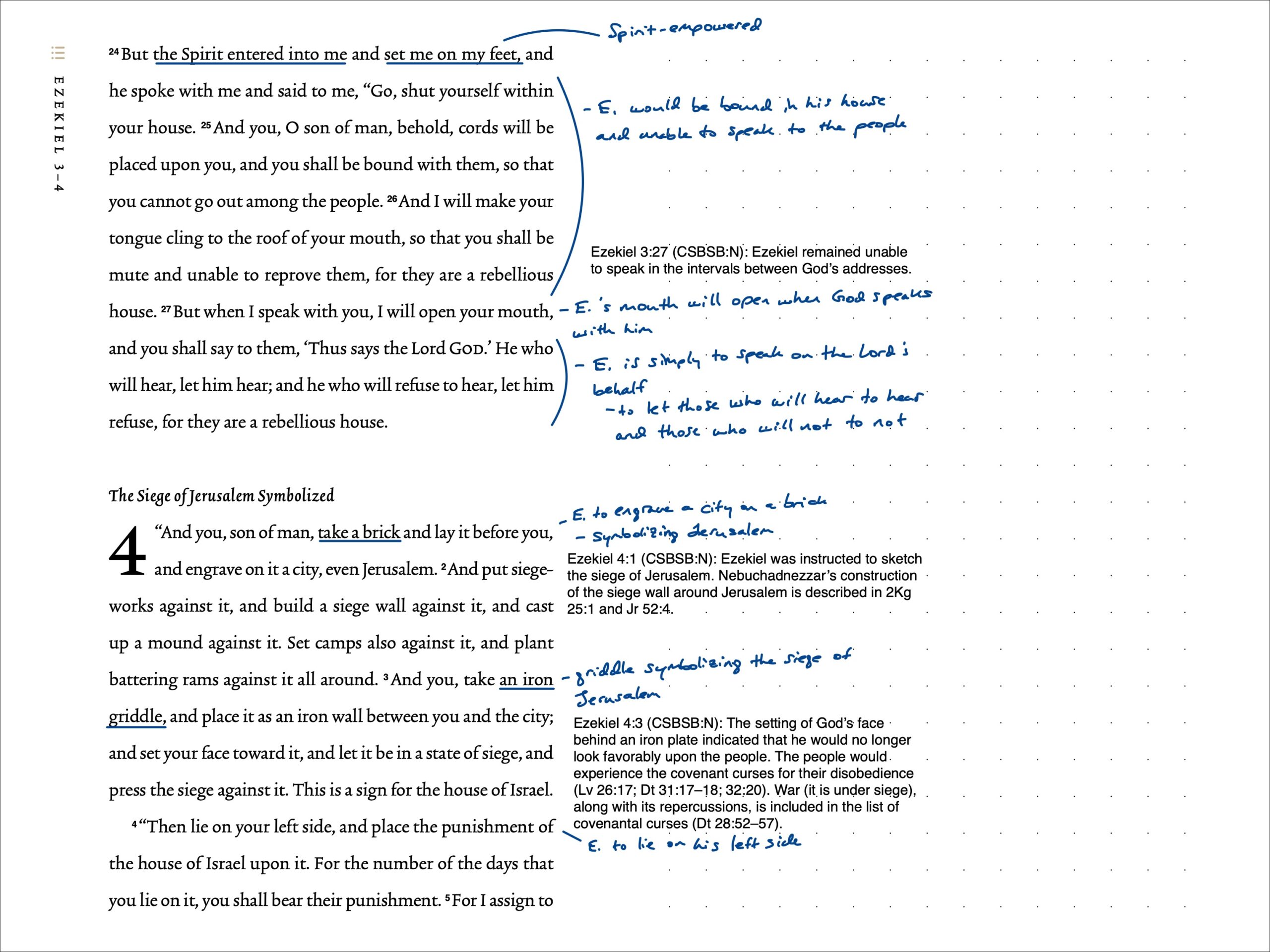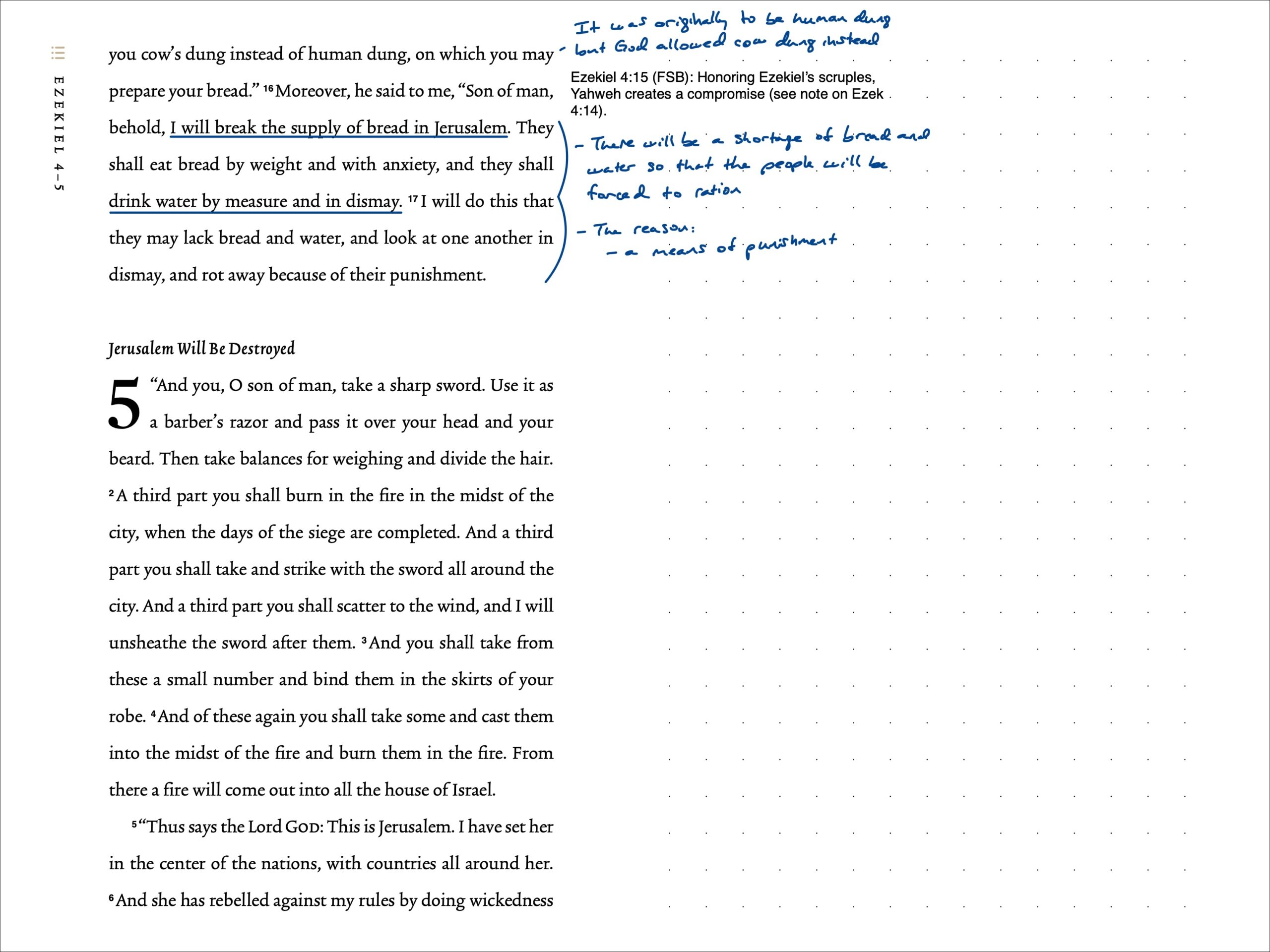| Date | Version | Reading Plan |
|---|---|---|
| @August 24, 2023 | ESV (2016) | ESV Prophets Plan 2023 |
Pericopes
- The Siege of Jerusalem Symbolized
Notes
The chapter opens with Ezekiel given command to engrave a brick with a city, Jerusalem. It was a sketch of the siege of Jerusalem. Nebuchadnezzar’s construction of the siege wall around Jerusalem is described in 2 Kings 25:1 and Jer. 52:4.
In Ezek. 4:3, Ezekiel is to place an iron griddle (or plate) between himself and the city as another symbol. The setting of God’s face behind an iron plate indicated that he would no longer look favorably upon the people. The people would experience the covenant curses for their disobedience.
In Ezek. 4:4-8, Ezekiel is told to lie on his left side for 390 day for Israel and on his left side for 40 days for Judah. The number of days lying on each side was to be the number of years of their punishment. Each day represented a year, but no explanation of the totals is completely satisfactory. Many commentators suggest that Ezekiel only laid on side during the part of the day that it would be seen by the public, since it was a visual teaching aid. Ezekiel was to be bound by cords until the days of siege were completed (Ezek. 4:8).
Ezek. 4:9-11 describes the food and drink Ezekiel was to consume while laying on his side. Precise ingredients and measurements are used. Food eaten was to “be by weight, twenty shekels a day” (Ezek. 4:10) and drink by measure, “the sixth part of a hin” (Ezek. 4:11).
In Ezek. 4:12-13, Ezekiel is instructed to bake in the sight of the people on human dung. Animal dung was a common fuel for cooking fires in the ancient Near East, as wood was too valuable for these purposes. However, human dung was considered unclean and using it would make a person impure (see Deut. 23:12-14). The LORD told Ezekiel that the people were to “eat their bread unclean, among the nations where I will drive them.” (Ezek. 4:13)
In Ezek. 4:14-15, Ezekiel makes an emotional appeal with the Lord that he had never defiled himself from his youth. The Lord responds favorably to his plea and allows for cow dung to be used rather than human (Ezek. 4:15).
The remaining verses (Ezek. 4:16-17) are of the extreme shortage of food and water for the people. God will “break the supply of bread in Jerusalem”, forcing them to ration and “eat bread by weight and with anxiety” (Ezek. 4:16). The reason is given in the final verse, that they will lack bread and water, looking at each other in dismay “and rot away because of their punishment.” (Ezek. 4:17)
Application
Ezekiel was employed to use some interesting symbols in this chapter: a brick for Jerusalem, a griddle for the impending siege wall and days laying on his side to represent years of God’s judgment. The symbols were meant to provide the people with distinct analogous depictions of their sin and resulting judgment. These gestures may seem odd to us, but would have been better understood in their original setting.
Thankfully, we in no longer need for such things. God, in His grace, has given us His Word by which He reveals to us our sin and need for repentance. The centerpiece of His revelation is the coming and propitiatory work of His Son Jesus Christ. We have no need for images and figures because God Himself put on flesh and dwelt among us. It is this reality to which we respond; either to deny Him or fall down at His feet and call Him Lord.
Scripture Journal Notes
Commentaries & Resources Used
- ESV Study Bible. (Wheaton, IL: Crossway, 2008)
- Faithlife Study Bible (Lexham Press, 2016)
- Believer’s Bible Commentary (Thomas Nelson, 2016)
- CSB Study Bible Notes (Holman Bible Publishers, 2017)
- Matthew Henry’s Commentary on the Whole Bible (Guardian Press, 1976)
- The Bible: A Reader’s Guide (Sterling Publishing, 2011)
- The Infographic Bible (Zondervan, 2018)
- ESV Digital Scripture Journal (Crossway, 2019)


